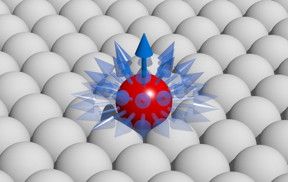Page 11016
Jul 11, 2016
Russia Offers India Nuclear Aircraft Carrier
Posted by Karen Hurst in categories: futurism, military
NEW DELHI — Russia has offered its nuclear aircraft carrier, dubbed “Storm,” to India for purchase, a senior Indian Navy official said. The offer comes as India and the US discuss the transfer of technology for India’s future nuclear aircraft carrier, the INS Vishal.
A diplomat with the Russian Embassy confirmed that a Russian team visiting India last week made the offer.
Krylov State Research Center (KSRC), a Russian shipbuilding research and development institute, is designing the carrier, also known as Shtorm or Project 23000E.
Continue reading “Russia Offers India Nuclear Aircraft Carrier” »
Jul 11, 2016
Atomic bits despite zero-point energy? Jülich scientists explore novel ways of developing stable nanomagnets
Posted by Karen Hurst in categories: computing, mobile phones, nanotechnology, particle physics, quantum physics
Stable nanomagnets that ultimately improves data storage on the smallest of devices.
Abstract: So-called “zero-point energy” is a term familiar to some cinema lovers or series fans; in the fictional world of animated films such as “The Incredibles” or the TV series “Stargate Atlantis”, it denotes a powerful and virtually inexhaustible energy source. Whether it could ever be used as such is arguable. Scientists at Jülich have now found out that it plays an important role in the stability of nanomagnets. These are of great technical interest for the magnetic storage of data, but so far have never been sufficiently stable. Researchers are now pointing the way to making it possible to produce nanomagnets with low zero-point energy and thus a higher degree of stability (Nano Letters, DOI: 10.1021/acs.nanolett.6b01344).
Since the 1970s, the number of components in computer chips has doubled every one to two years, their size diminishing. This development has made the production of small, powerful computers such as smart phones possible for the first time. In the meantime, many components are only about as big as a virus and the miniaturization process has slowed down. This is because below approximately a nanometre, a billionth of a meter in size, quantum effects come into play. They make it harder, for example, to stabilise magnetic moments. Researchers worldwide are looking for suitable materials for magnetically stable nanomagnets so that data can be stored safely in the smallest of spaces.
I reported on this 3 weeks ago; however, here is a newer article on the quantum entanglement chaos. This article highlights Google’s involvement.
Researchers at UCSB blur the line between classical and quantum physics by connecting chaos and entanglement.
Jul 11, 2016
Manoj Saxena talks Artificial Intelligence with Gigaom
Posted by Karen Hurst in categories: finance, health, robotics/AI, security
Nice chime on QC.
Manoj Saxena is the executive chairman of CognitiveScale and a founding managing director of The Entrepreneurs’ Fund IV (TEF), a $100m seed fund focused exclusively on the cognitive computing space.
Saxena is also the chairman of Federal Reserve Bank of Dallas, San Antonio branch and Chairman, SparkCognition an Austin based cognitive security and safety analytics company.
Continue reading “Manoj Saxena talks Artificial Intelligence with Gigaom” »
Jul 11, 2016
A Sci-Fi Short Film: “THE SIGNAL”
Posted by Sean Brazell in categories: energy, entertainment, internet, media & arts

Enjoy this VFX Sci-Fi Short Film… 2046. A new energy source, created to solve the world’s energy crisis, is believed to have deadly side effects. When The Signal’s inventor chooses to help a girl warn the public, he gains an unlikely ally to save the world from his own creation. Starring Michael Ealy and Grace Phipps, Written and Directed by Marcus Stokes!
On the web — http://www.thesignalmovie.com
Jul 11, 2016
Mars Colonisation Transportation: Project Revelation Before Rumours
Posted by Michael Paton in categories: Elon Musk, government, space travel
Translated this intriguing article for English readers about our soon to occur Mars-Colonisation, and prospective announcements at the upcoming SpaceX Event!
In our analysis of end 2015 (available on our website, and its summary in the English section) we tried to discern what might look like the project SpaceX Mars Colonization Transportation (MCT), Elon Musk has finally unveiled Sept. 27 at the next International Astronautical Congress. This year included the meagre clues gleaned from the various statements of the contractor, some alter the previous information (eg abandonment of multi-body launcher formula type Falcon Heavy) or, coercion, seemed to confirm the fundamental options such as refuelling earth parking orbit by a second launcher, the total reuse and descent of March of the entire interplanetary shuttle ( “landing the whole thing”). Since then, other indications of various origins have appeared on fans forums. Examine their possible significance.
The choice single-body launcher recoverable and we had driven to approach the performance target (100 T Payload deposited on Mars) to increase the diameter of the drive bay 15 m, although it seemed sufficient to limit that of upstairs itself to 12.5m (pm the first two stages of the Saturn 5 moon had a diameter of 10 m). This configuration allowed to stay a maximum of 31 engines of 300 T thrust and achieve take-off weight (GLOW) 7750 T. Unfortunately, the shape flared rear of the first floor, certainly favourable to the stability phase of ascent, is very unfavourable for the return (flight in opposite direction), especially since it has less then effective ways to stabilise the trajectory. Since it is difficult to imagine that we can reduce the GLOW and therefore the take-off thrust, the solution is to increase the diameter of the whole floor to 15 m. Now it is one of the rumours on forums “MCT-geeks”; SpaceX had solicited tooling suppliers for this diameter.
Continue reading “Mars Colonisation Transportation: Project Revelation Before Rumours” »
Jul 11, 2016
‘Crowd Control,’ part 22: Spies in heaven
Posted by Zoltan Istvan in categories: cosmology, geopolitics, transhumanism
The final chapter in CNET’s historic “crowdsourced” sci-fi novel is out. You can read the whole thing here. Transhumanism is a large part of it (and a fictional version of my being President is in it too). This book was written by the participating public. This was a huge plus for the Transhumanist movement, as it meant transhumanism appeared many times on CNET as chapters were released (CNET is the world’s leading tech site in traffic):
In the finale of CNET’s historic crowdsourced sci-fi novel, the war on Earth is over, but the story of the multiverse may just be getting started.
Jul 11, 2016
The Freaky Artificial Muscles on this Human Skeleton Are the Future of Robotics
Posted by Sean Brazell in category: robotics/AI
Using pneumatic pistons and servos to power robots makes them fast and strong, but also bulky and extremely heavy. No one is going to mistake ATLAS for a real human being. To eventually create humanoid-looking robots like the Terminator we need to mechanically replicate every part of the human anatomy—starting with the muscles.
Researchers at the Suzumori Endo Robotics Laboratory at the Tokyo Institute of Technology started with an artificial human skeleton that was then covered in bundles of multifilament artificial muscles. Like real human muscles, the multifilament bundles contract and expand when an electrical current is applied, and by controlling different groups of these muscles at different times, the skeleton’s arms, legs, and head can all be made to move similar to how a real human can.
Continue reading “The Freaky Artificial Muscles on this Human Skeleton Are the Future of Robotics” »
Jul 11, 2016
3 Reasons You Are Living in the Matrix / How to Make a Red Pill
Posted by Eric Baum in categories: complex systems, disruptive technology, education, governance, government, philosophy, physics, policy, rants, science, scientific freedom
 “Appearances have always played a much more important part than reality in history, where the unreal is always of greater moment than the real.“
“Appearances have always played a much more important part than reality in history, where the unreal is always of greater moment than the real.“
–Gustav LeBon, The Crowd (1895)
I’ve gotten no substantive response to my last post on vaccine safety– neither in the comments, nor the TruthSift diagram, nor anywhere else, nor have the papers I submitted to two medical journals… but I have gotten emails telling me I’m delusional and suggesting I seek psychiatric attention. And this of course is integral to the explanation of how such delusions as vaccine safety persist so widely when it is so demonstrably a delusion: the majority who believe the majority must be right because its the majority are emotionally unwilling to confront the evidence. They assume the experts have done that, and they rely on the experts. But the experts assume other experts have been there. Ask your Pediatrician if he’s personally read Bishop et al and formulated an opinion on vaccine aluminum. Neither has the National Academy, except perhaps their members have and decided, perhaps tacitly, not to review the subject. Their decision not to review the animal literature was not tacit, they said they explicitly decided to omit it, although elsewhere they say they couldn’t find human evidence that addressed the issues. So everybody is trusting somebody else, and nobody has picked up the ball. And can you blame them? Because when I pick up the ball, what I receive in return is hate mail and people’s scorn. The emotional response cuts off any possible inspection of the logic.
On most questions where a majority with authority is facing a minority of dissenters or skeptics, the majority is delusional.
In other words, you are living in the matrix; much of what you and people believe is fundamentlaly wrong.
Reason 1, as above, is that the majority forms its view by circular reasoning, and rejects any attempt at logical discussion without considering it seriously, so it is prone to delusion.
Once the crowd concluded vaccines are safe and effective, for example, the question of whether the aluminum is damaging can apparently no longer be raised (even as more gets added to vaccines). And when I or others try to raise it, we are scorned and hated, and ineffectual in changing the opinion supported by circular reasoning. When new research papers appear that call it into question, they are ignored, neither cited in the safety surveys nor influencing medical practice in any way. This paragraph is all simple reporting of what has repeatedly happened.
Continue reading “3 Reasons You Are Living in the Matrix / How to Make a Red Pill” »
















